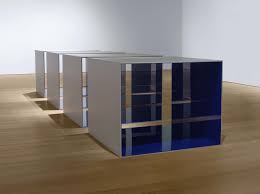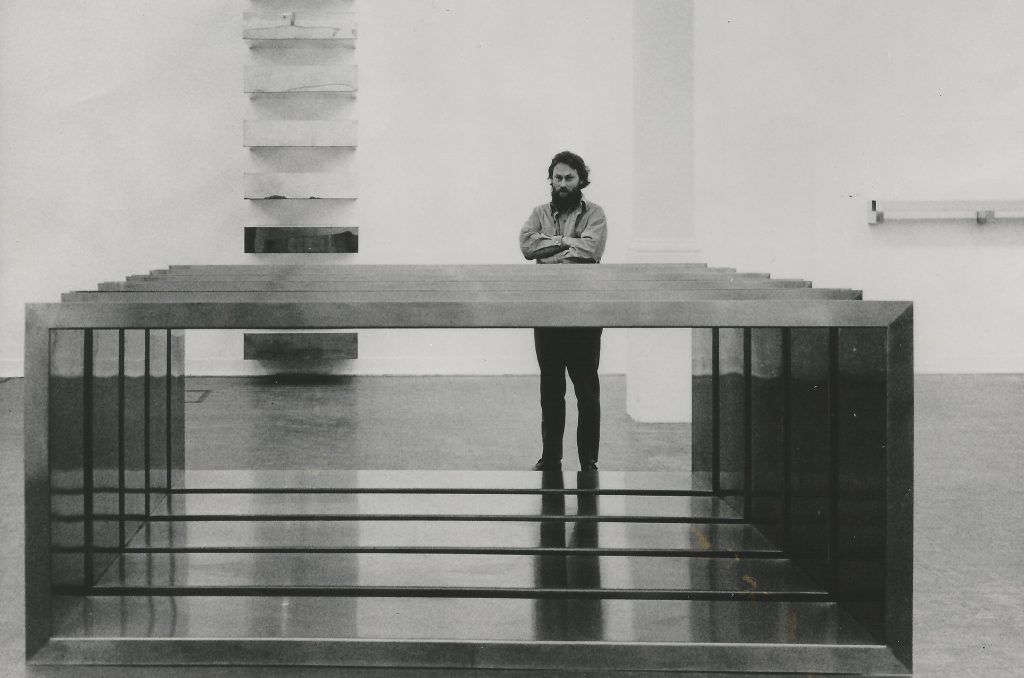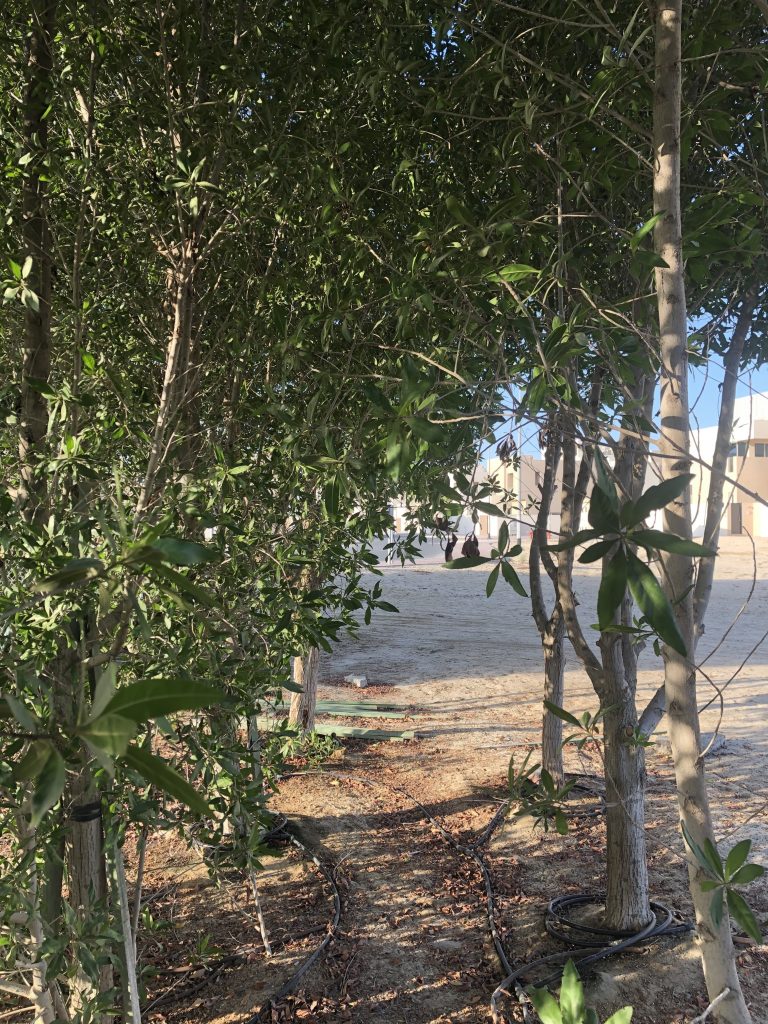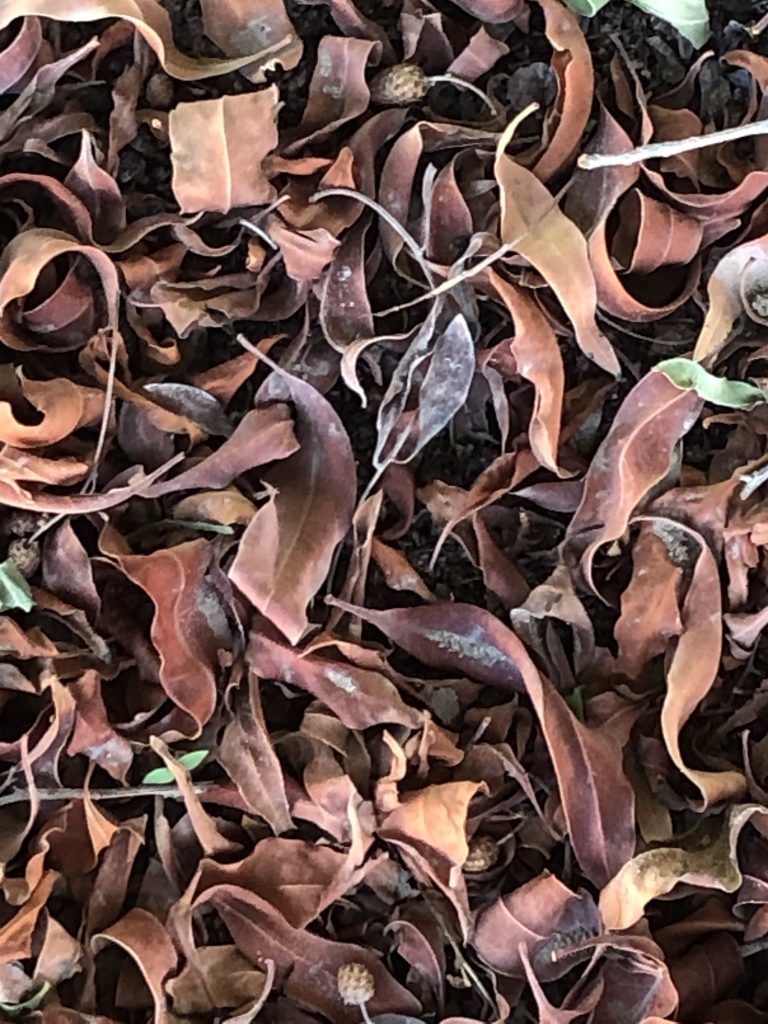TOPIC 3 : SITE SPECIFICITY
EXERCISE 4.5 PHENOMENOLOGY AND MINIMALISM
Look up the writings of Edmund Husserl and Maurice Merleau-Ponty and summarise three of their main points in relation to Minimalism in your learning log.
I first educated myself with regards to how phenomenology and minimalism are defined. According to the Standford Encyclopedia of Philosophy:
Looking at the origin of the word, its etymology is from Ancient Greek – phainomenon: “thing appearing to view’. Merriam Webster give the definition as follows: “the study of the development of human consciousness and self-awareness as a preface to or a part of philosophy. ” So one can say – that which appear, distinct from that of being and then logos – study.
Phenomenology is the study of structures of consciousness as experienced from the first-person point of view. … Phenomenology has been practiced in various guises for centuries, but it came into its own in the early 20th century in the works of Husserl, Heidegger, Sartre, Merleau-Ponty and others. Nov 16, 2003 Associated Authors: Edmund Husserl; Maurice Merleau-Ponty…
Phenomenology (Stanford Encyclopedia of Philosophy)plato.stanford.edu › entries › phenomenology I understand it as a way describe the meaning of experience—both in terms of what was experienced and how it was experienced. Phenomenology became a way of showing the essential involvement of human existence in the world, starting with everyday perception.
Merleau-Ponty later developed in the direction of Heidegger, a change that became particularly open in his L’Oeil et l’esprit (1964; “Eye and Mind”).
Edmund Husserl (1959 -1938)
He established the concept of intentionality in philosophical and
phenomenological terms, each being related to perception. In 1936, Husserl said: ‘From what rests on the surface one is led into the depths’ (Welton 1999: ix). It states that that what is there is not only what is visible. Husserl was interested in the nature of knowledge – an epistemological focus. Thus, the objects of phenomenology are “absolute data grasped in pure, immanent intuition,” and its goal is to discover the essential structures of the acts (noesis) and the objective entities that correspond to them (noema). Considerations to objective reality are not taken into account.
For Husserl intentionality has the components noesis, noema and horizon. Noesis (idea) and noema (object or content of the act)) are interdependent, existing in synergy with each other but with individual meanings and relevance. Noesis refers to the consciousness of something or an object, while noema is the perception of the same something or object. They coexist and reference the same something. The horizon may be described as the difference between the real and perceived elements of an object. Is almost as if the consciousness is stimulated by the process of perception, which is more transcendental.
Maurice Merlaeau-Ponty
- Perception is positioned by him as a system of meaning by which a phenomenal object is recognized. This would imply that I and my perception of the world can be inextricably linked as well as mutually involved, as every conscious action and experience is channeled through perception, which can be seen as a more bodily perception.
- Minimalism uses this perception and how we consciously attribute meaning to the world as essential, as it desires to relocate origins of meaning to the outside. According to Ponty the function of consciousness is not only to represent/signify, but to develop and sensory material and free the object from any determined meaning.
- He sees objects and experiences as subjective, temporary and unfixed. Each experience becomes/creates a gestalt., becomes exhausted and replaced by a new gestalt. It is clear that experience transcends thought. In Minimalism one cannot derive meaning from the object itself.
I feel my learning I take from looking at Phenomenology, that one cannot take process away from these ideas – the practice lies within (grounded) the process. As a researcher one has to suspend your own attitudes, beliefs, and suppositions in order to focus on the participants’ experience of the phenomenon and identify the essences of the phenomenon.
Welton, D 1982, Research in Phenomenology Vol. 12 (1982), pp. 59-83 (25 pages)
Cobb-Stevens, Richard. “The Other Husserl and the Standard Interpretation.” Research in Phenomenology, vol. 33, 2003, pp. 315–328. JSTOR, www.jstor.org/stable/24660625. Accessed 20 Dec. 2020.
EXERCISE 4.6 THE SOCIAL FRAME
Describe in your learning log how the works below critique the institution:
Mel Bochner, Measurement series, 1969
Above series by this conceptual artist started off as works on brown paper marked with the sheet’s dimensions and gave a critique on minimalism. He investigated process where theme, like modular techniques was used by the artist (thematization of artistic process), as well as art as epistemological inquiry, and the foregrounding of context in art. The artist used black tape to draw simple, linear segments across the surfaces in a small gallery in Munich in May 1969. Numbers corresponded to the length of the measured surface – like the width of the window bay, the height of the doorframe – a start of a series that continued around architectural space like that of a gallery. I viewed a recent video conversation with the artist by Dia Art, New York (8 February, 2020) which celebrated the 50th year of his first Measurement installation. Since 1969 scale and gallery space became much bigger – history of display changed. Discussing this he said that certain things/ideas have the potential to return, you do not know that when you do something (because you do it in response to something) – look back reflectively on the notion of display – we changed our own perception of scale. Now we scale it up – experiment with sizes – large enough to see, not to become graphic design. One is always negotiating the space, no predictability of what would be right – position is at his eye level – always 72”. He always works in inches and feet as measurement. Essential point: can we believe this?
Looking at the installation, The Working Drawings and Other Visible Things on Paper Not Necessarily Meant to be Viewed as Art – here the books become a way to look at ‘dematerializing’ the work into a reproducible idea.

Working Drawings and Other Things on Paper Not Necessarily Meant to be viewed as Art, 1966 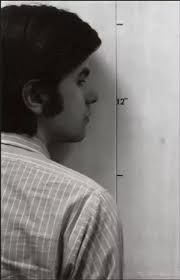
Mel Bochner, Actual Size (Face), 1968
In these Working Drawings he also used ‘other visible things’ – such as pennies, match sticks, glass and pebbles. His Measurement Series continued investigations of space, again a theme, which included measurement of arcs, the gallery itself. He commented as follows: “For me, the use of self-generating procedures to make art was a liberation from the limitations of my own ego. It represented an escape from individualism by the objectification of process.” (Meyer, 1995) He continues to talk about how do an artist define what he see or know – his measurement series was in reaction to being unable to put anything on paper and then looking at these two sheets of paper he had on the wall he observed the space between them. “I saw that it was a much the subject as the paper. I measured the distance and drew it on the wall….when I took down the sheets of paper I had the measurement alone. It puzzled me. It still puzzles me, What does it mean to have 25 inches drawn on the wall?” (Meyer, 1995) Here one find the artist going beyond the confines of the object – he looks at shapes and their perception when seen and describe the measurement area in a numeric analogue. He started working on brown wrapping paper, a standard size, made the measurements, found objects, not adding what he had. This leads to looking at ‘standardization’ and our (viewers) experience of these ‘created’ conditions (beliefs in measurement as we believe measurements are verified, thus the truth). The space of the wall started to enter and became more interesting than the paper. In his video chat he referred to the dominant discourse at that time, namely, minimalism, and that he looked to the artist, Donald Judd’s work, his boxes series.
Mel Bochner saw it as the room, collapsed – he thought about what could be the largest object in a space – and said, it is the space and that is how it became the ground for his interventions into the space. He critiques the expressionist model and inserts language (mathematical and written) in the pictorial field. He attempts to ‘purge’ subjectivity, works more in series – a way of being in the world as an artist, and not being part of a stylistic commonality. ( use of graph paper?) I see him looking at serial work with a commonality that runs through – possibilities that open up in this space whilst at work. It is not that art does not need expression, or that materialism is enough – he discovers that to eliminate physical and visual is not possible. He prefers not to think about ideas, would rather call it intuitions, reponses, as it refers to the unpredictability – his experience is that nothing is really predictable – he sees the ‘fun’ in this process of not knowing the outcome.
I viewed 8″ Measurement, 1969, which seems to be part of the Stenn Collection. I would agree that it is difficult to describe it as a drawing – it is clear he uses the 8″ x 8″ demarcations of the paper – it is a statement written onto the graphpaper – like the arrows extending past the printed demarcations of the paper, shows an investigation into the idea of measurement.

Meyer describes his work as follows:
” Bochner’s Measurement works narrate, with seemingly inevitability, a transition form the canvas to paper, form paper to expanses of wall, from the wall to the tree-dimensional, ‘pure space’ of the modernist gallery. They recuperate, for the post war era, the legacy of institutional analysis of Russian constructivism and Duchamp: the context of the work is the “work”. ”
Having looked at Bocher’s work, I think I understand more of interacting with space and I did some investigations in my walking around how I could translate that into my interactions with space. I loved his measurements and use of repetition ( revisit the words or ideas in more works) as it related to some readings I did about urban space development and our perception – it motivated me to cut up my works and interact with ideas I had around maps and how to materialize it into my own embodiment of walking. It made me question the fact that if I am outside, why do I feel bound by space – I started looking differently at space around me – saw more possibilities to explore. (Parallel Project November 2020 blog) I started making experimental drawings – based more on chance than being figurative or even abstract. I researched that topic with the help of a doctoral thesis in Philosophy I found on the internet, M Halpin, 2019.

It also became clear to me that Bochner wrote a lot of short essays and articles to add to his thinking and research (language based) in his creative work process. His work should be read as extensions of his thinking process about art – it would start with drawings that would lead to paintings, but all through intuition. I also find it interesting that he worked on graph and lexicon paper – is it seen as ‘objective tools’? His use of words and numbers in his materials could have helped to explore the limits of language? On Artforum (April 1986) I read that his work was seen as having a resemblance to the methods of L Wittgenstein and they refer to a Wittgenstein famous recommendation: “Don’t ask for the meaning, ask for the use”. So Buchner was completing this in the artist way – from language to visual (sight) In the Artforum article the writer ( Jan van der Marck) refers to his works in 1966-1968 as attempts to ‘literalize space’ by involving measuring and coundings.
Daniel Buren, Within and Beyond the Frame, 1973
This work consisted of 19 banners painted on both sides with stripes were hung inside and outside of the John Weber Gallery. Nine pieces were hung inside the gallery with a middle banner connecting the remaining nine banners hanging outside of the gallery across West Broadway Street in New York. The identical banners were framed in two contexts, shows the idea of the surrounding providing different frames to the same objects. They were shown in the cultural context of an art gallery and the urban frame of New York city. The fact that the same banner was hung in this way made that the context in which they were placed gave them a different meaning. Buren has explored this idea with his site-specific works up until today. It seems that he is known for “examining” how an object or sign is transformed as it traverses physical and conceptual boundaries. As a young conceptual artist, he was considered visually and spatially audacious, objecting to traditional ways of presenting art through the museum-gallery system and became famous for his 8.7-centimeter-wide alternating white and colored vertical stripes, deployed as strong, elegant, minimal paintings.
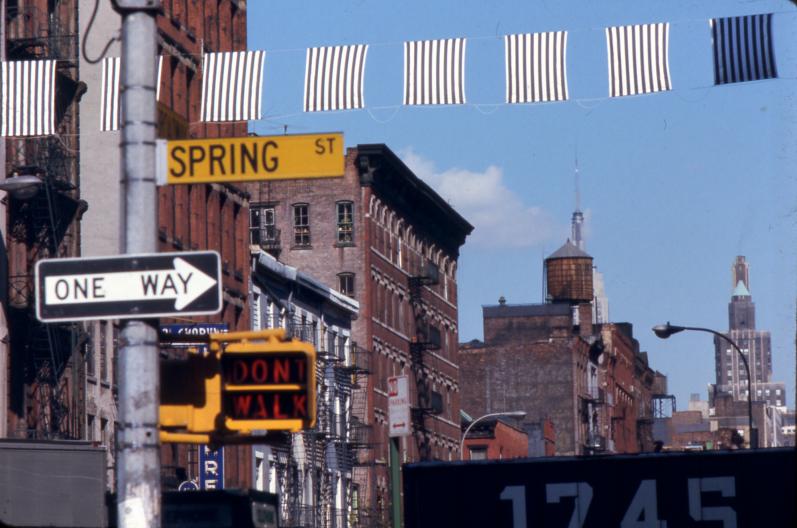
Buren wrote essays in this period critiquing the museum in that the museum imposes its frame on everything that is exhibited in it, because “everything that the Museum shows is only considered and produced in view of being set in it.” (J Nechvatal, Sept 2016) , and later in his 1971 essay, “The Function of the Studio,” the artist argued that an “analysis of the art system must inevitably be carried on” by investigating both the studio and the museum as the “ossifying customs of art.” On the TATE website I do some more research about his work: ” the alternating white and coloured stripes, each a standard 87 mm thickness, has been the basis for all his subsequent work. Buren’s use of this material, which is never marked and is only altered in length and width, evacuated any trace of the hand of the artist, questioning what might be considered art and the parameters of the art object. Importantly the repetitive design of the vertical stripe as well as his repeated use of the pattern throughout his career, provided Buren with a visual tool with which he could examine the relationship between an artwork and its environment.“
By writing many critical essays Buren pursued the critical engagement with art institutions that characterized his practice since 1967. He took to an approach by focussing on functions performed in the studio, the gallery and museum in the production, presentation and distribution of art. He spoke out against the notion of the autonomous work of art and the assumption of a neutral setting. To him it was about the ‘frame’ in which an artwork was presented – be it the canvas, the venue, or the social context. He states that this always got involved in the production of meaning and itself undergoes changes in function depending on the definition of art brought to bear in any given case. He clearly challenged with his work how the gallery had the power to declare anything it exhibits as art.
I looked at a contemporary work of Buren – “Observatory of Light (2016) at the Foundation Louis Vuitton, situated in the Jardin d’Acclimatation, in Bois de Boulogne, Paris. J Nechvatal (Hyperallergic.com Sept 2016) describes this work as: “another example of how once-radical conceptual artists have become co-opted and turned into spiffy designer-decorators.” In this work, as seen below, Buren has masked 3,600 pieces of checkerboard-like translucent colored glass with punctuated panes of white stripes to cover a building. Nechvatal in the mentioned writing questions the artist’s ideas of Institutional critique, by saying its now historical status as counter-establishment, and is the “aloof calling card” of the resultant lite light show the artist has created. I feel I have a different opinion – the long process of creating this ‘aloof calling card’ is what makes Buren’s work so interesting – I clearly learnt from his work that a thing, idea/work of art/installation, never only exist only in itself – it is very dependant on the space it finds itself in. To me it opens up the possibilities of working with an environment and knowing it will always change. I get the idea that by continuing on this questioning as a work process, the artist must have become much more clear about what his work is about – he positioned it outside his studio and the gallery, which is still the traditional framework for art. I believe this also indicates art’s capacity for self-reflective critique


Meyer, James, 1995, Bochner’s Measurement Series published as an essay in the catalog for and exhibition at Moma, Mapping, 21 January – 18 February 1995. Published by M.Rose Publications. Accessed online (www.theartsection.com) on 14 December 2020. (contains letters and quotations from the artist)
Nechvatal, J 2016 How Daniel Buren’s Institutional Critique Became Institutional Chic, Hyperallergic.com Sept 2016, read online on 13 December 2020
REFLECTION ON WORK IN THIS PART:
I want to share some learning I can take to my own practice and Parallel Project. Nicolas Bourriaud (1998) suggest that the role of artworks, whilst we are learning to inhabit the world in a better way, is thus no longer to form imaginary and utopian realities, but to “actually be ways of living and models of action within the existing real, whatever the scale chosen by the artist.”
- Art became relational, versus independent and private and in symbolic space – city life has changed us culturally to have more encounters with art and artists among each other. I want to share his comments on art exhibitions:
At an exhibition, on the other hand, even when inert forms are involved,
there is the possibility of an immediate discussion, in both senses of the term. I see and perceive, I comment, and I evolve in a unique space and time. Art is the place that produces specific sociability. It remains to be seen what the status of this is in the set of “states of encounter” proposed by the City.
- Relational aesthetics represent a theory of form – forms are developed by artists as a way to ‘come across’ – “When the individual thinks he is casting an objective eye upon himself, he is, in the final analysis, contemplating nothing other than the result of perpetual transactions with the subjectivity of others” (Bourriaud, 2002, 21)
- form is a representation of desire – Producing a form is to invent possible encounters; receiving a form is to create the conditions for an exchange, the way you return a service in a game of tennis.
- Form is a dynamic of time and space – it can come about from that meeting/interaction with time and space.
I was contemplating how my walking practice ( Parallel project) relates to above ideas and came upon an article published by the Art Story – here the following was noted about Bourriaud: “..Art historian Claire Bishop, who spent much effort in quantifying and analyzing the controversial new term, noted, “It is important to emphasize, however, that Bourriaud does not regard relational aesthetics to be simply a theory of interactive art. He considers it to be a means of locating contemporary practice within the culture at large: relational art is seen as a direct response to the shift from a goods to a service-based economy.” I agree with the writer of the article when its states that the strategies of relational art have come to make up part of the standard vocabulary of many contemporary artists, and the concerns of relational art (everyday life, social interaction, political critique, and social change) have become primary concerns within a wide range of contemporary artworks.
Reading about the Dadaists, they were among the first artist to really think about art conceptually and now I can come to an understanding and practice of art which is not restricted to the production of aesthetic objects to be exhibited within institutions. Their non-object-based practices such as installation and performance were an exploration of new artistic routes and in this process, the Dadaist had to grapple with pivotal questions regarding the role of the artist and the fundamental nature of art. Ideas such a ‘happenings’ and improvisation were tested in their work practices. I also think the Situationists, who were driven by political and social during 1957 to 1962 were focused on creating works that brought people into direct encounters and experiences with each other. Their strategy of the “dérive,” defined by Debord “as a mode of experimental behavior linked to the conditions of urban society: a technique of rapid passage through varied ambiances.” I learnt that a dérive was an unplanned journey, like walking through a city’s streets, during which the individual (Debord called him/her a “psychogeographer,” understood as a sort of “flâneur” or romantic wanderer/stroller) allowed him/herself to be fully aware of, and engaged with, the surrounding environment. They also organized “situations” which were very similar to “happenings.”
By now I have started to explore chance in my work and also looked at how I could use shadow and light in this process. ( See parallel project, dated 28 December 2020) I am also learning that ‘site’ and ‘specificity’ of art opens up many new understandings of ‘place’. One has looked at ‘site’ as something fixed. Kwon (2002) writes in her Genealogy of place about three possible ‘paradigms’ which relate to artists’ engagement with site, by debating phenomenological, social /institutional, and discursive design around site-specific work. For her site to view the art object was within the context of a sensory and bodily presence; site as a phenomenon happens through social/political processes and through ideas of locale – the artwork ‘conceives’ the site as something more than a place and then where the site is not defined as a precondition, the work as content becomes the discursive formation of site – could be in a neighbourhood or art as a seasonal event, have historical conditions – it is about ‘sense of place. Kwon moves away from literal interpretations of site towards multiple meanings of site.
So would this imply that I should look at the assignment with the following in mind:
- the work should deal in terms of its location, materials with the architectural/design/layout/configuration of the site (aesthetic and geographical qualities of the compound where I walk)
- the work should deal with the specificity of the ‘sense’/spirit of the place by using something of the history of the place (This is a home from home space, in a culture which by many is seen as the ‘other’ – can I “re interpret it’ – my experience and associations when walking?)
- the work should fit into the co operation with the users of or community (within) the space – be sensitive/considerate to their needs (living and community space for families)
When I look at the images above, taken on a walk, I feel I can create a work about the experience (as content) around living. The title of the work is a paradox, as there are only sidewalks to walk along the roads, the ‘footpath’ is mainly to irrigate the trees and keep the fence around the compound clear/maintenance. I created a connection with nature by using this path in my walk, which could be an awareness of the effect of our living on natural areas, such as this coastal site, which now house a very busy port, hotels, and entertainment, heavy industry (gas/aluminum, etc) as well as the neighborhoods and the planned palm island development.
‘Beyond these dual expansions of art into culture, which obviously diversify the site, the distinguishing characteristic of today’s site-oriented art is the way in which the art work’s relationship to the actuality of a location (as site) and the social conditions of the institutional frame (as site) are both subordinate to a discursively determined site that is delineated as a field of knowledge, intellectual exchange, or cultural debate. Furthermore, unlike in the previous models, this site is not defined as a precondition. Rather, it is generated by the work (often as “content’), and then verified by its convergence with an existing discursive formation.’
Kwon, 2004:26
Bourriaud, N. (2002) Relational Aesthetics. Dijon: Les Presse Du Reel. pp. 11-24
read online at:
http://post.thing.net/files/relationalaesthetics.pdf (Accessed on 26.12.20)
Kwon, M (2004) One Place after Another, Site-Specific Art and Locational Identity. Cambridge MIT Press read online at https://monoskop.org/images/d/d3/Kwon_Miwon_One_Place_after_Another_Site-Specific_
Art_and_Locational_Identity.pdf Accessed on 26 December 2020
Relational Aesthetics article at: https://www.theartstory.org/movement/relational-aesthetics/history-and-concepts/ Acsessed on 23 December 2020
